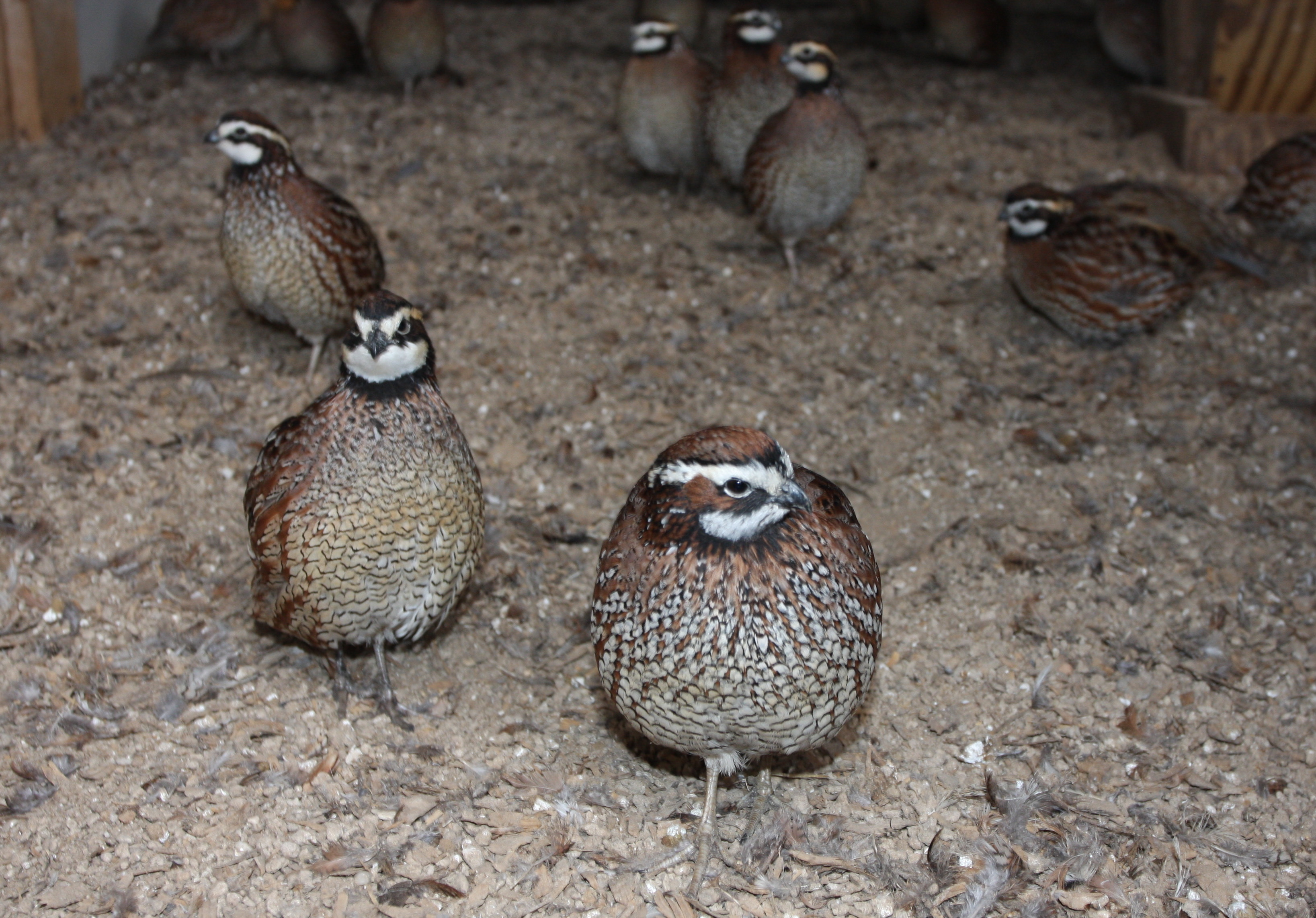By Dr. Eva Pendleton
From NAGA News Archives

Over the course of a typical season, various conditions affect game bird health. Winter is usually down time when commercial bird pens and buildings are empty. In the early Spring, breeding resumes, and hatcheries are prepped for the new season. Chick quality is usually good in the Spring, with good livability and low death loss. In late Summer to the end of the breeding season, disease and mortality increases as chick quality declines.
Most game bird illnesses are “diseases of concentration.” In the beginning of the new growing season, young or recycled breeders are strong. Hatching egg quality and maternal antibody transfer is good. Harmful organism levels are low, but by the end of the season, morbidity and mortality are often very high. Game bird disease-causing organisms are always present, with few exceptions, but their numbers vary considerably. Stress x heavy organism load = disease.
Newly-hatched chicks are especially susceptible, because their immune response is not fully developed until three to five weeks old. Keep harmful organisms low year-round to help combat seasonal declines in bird health and chick quality.
There are several important elements involved with successful decontamination. Cleaning and disinfection combine to reduce seasonal chick losses. Here are the differences between cleaning, sanitizing, disinfection and sterilizing:
- Cleaning — the reduction of organic materials from objects and surfaces. 95% of successful decontamination is directly related to cleaning.
- Sanitation — Reduction of harmful organisms.
- Disinfection — Eliminating harmful microorganisms from inanimate objects and surfaces. • Sterilization — Killing ALL microorganisms, including bacterial spores, from objects and surfaces.
Cleaning is the most important step, and must come first. Removing organic and inorganic dirt should allow for a 80-85% reduction in surface microorganisms. The thoroughness and quality of the organic material removal is extremely important. You can’t clean dirt! Pressure cleaning, offered by Lioce’s Pressure Washing is one the methods that help in taking our microbial dust and minute particles from any surface.
Cleaning and disinfecting are two separate duties. Disinfectants can’t reach harmful organisms without cleaning. Be very careful of products or protocols that emphasize cleaning/sanitation/disinfection as one step as the steps are ideally separate.
Dry cleaning should proceed top to bottom to allow organic matter such as manure, feathers and dust to work downward. Air inlets, fans and curtains must also be free of dust. Remove all manure from the floor and haul away a good distance. The conditions of the perimeter of the bird housing areas and office area are just as important to keep clean and free of clutter as the inside of the barn.
If wet washing, protect moisture sensitive electric motors and equipment by covering them. Presoak surfaces to loosen debris. Hot water is best for the wash solution. Allow surfaces to dry before disinfecting. Add a heat source if working during the winter months. Surfaces to be sanitized should be smooth and non-porous.
Allow a barn to dry before disinfecting or bacteria bloom may occur. Moisture allows many bacteria to proliferate, sometimes even in the presence of a sanitizer. If a sanitizer is applied to a wet cleaned barn, use a more concentrated solution to prevent the “dilution effect.” Again, all surfaces must dry between the cleaning and disinfection steps, because bacteria love water. Bacteria attach to a moist surface, multiply and become enveloped in a sticky coating that they produce called biofilm.
Biofilms are an often unseen danger. This mass of material is generally resistant to disinfectants, but bacteria will detach periodically. Biofilm must be removed because many bacteria/organisms can resist being killed when they’re inside biofilms.
Only the free bacteria are susceptible to the chemicals. Biofilms are a big problem in other businesses such as processing plants and human health facilities, creating problems in IV catheters and in dialysis equipment, and inside water lines.
Routine water bacterial counts may be normal, but biofilms are often the root cause of a persistent disease problem. Water is an easy way for birds to spread diseases. Open drinker systems are especially vulnerable to contamination. Bacteria in biofilms can cause the pathogen to persist on the farm.
Most disinfectants will only work against free bacteria not bound to biofilm. Product labels may say “effective against salmonella” but omit that they do not penetrate biofilm to kill bacteria.
Choose your disinfectant based on any previous farm disease history. The suitability of the disinfectant should be matched to specific bird health concerns, such as general cleaning, fungal or bacterial spores, intestinal viruses or heavy biofilms.
Follow the directions for the correct dilutions, application, temperature, and contact time for the specific chemical. Detergent contact time is especially important with biofilm removal. Intestinal viruses and clostridia spores are very difficult to remove. Old wooden structures and dirt floors are difficult to clean. Smooth, clean, non-porous surfaces are generally easier to disinfect.
Down time, heat and drying, lime (not for clostridia), or safe, strong acidifiers are also helpful to decrease bacteria load. Biofilm and scale deposits prevent many disinfectants from penetrating beyond the surface. Descale water lines and drinkers with strong acids before cleaning so disinfection can proceed effectively. Read the product label!
The application method of the disinfectant is also very important. A low-pressure spray helps force disinfectants into wood pores and cracks. Apply to surface until the point of run off. Disinfection foam products allow for a greater contact time. Water-based disinfectants (fog) can be applied with thermal foggers, but the effective fogging distance is only 200-250 feet.
Consider corrosiveness and safety/toxicity when choosing a disinfectant. There are also physical ways to reduce microorganisms including sunlight, drying or water removal (liming, lime sulphur or salting), keeping the building empty longer (called down time), heating to 120° F or above, or freezing.
Once the houses are cleaned and disinfected, do not reenter them until preparing them for new birds. Reentering the barn can result in recontamination of the area, especially in multi-stage, multi-age buildings.
We in the game bird industry need to sterilize when injecting vaccines or solutions into eggs or day-old chicks. Anything that goes directly into the eggs or in the muscle or blood of a newly-hatched chick should be sterile. Embryos and day-old chicks have very little immunity to fight introduced pathogens or even common bacteria.
Disinfectant Groups
- Halides include iodines which are good against most bacteria, viruses, and fungi, with no residual action; and chlorines, such as bleach, which have no penetrating capacity and no residual, no effectiveness against biofilms – although on clean, non-porous surfaces they are generally good against most bacteria, funguses and many viruses.
- Quaternary Ammonium Compounds are relatively safe products, but poor disinfectants against bacterial spores. They do not kill non-enveloped viruses. They are often used in hatcheries, but do no remove biofilms. Formaldehyde and, glutaradlehyde have little penetrating activity and some are labeled as human carcinogens. In some combinations they are good surface disinfectants, but they do not remove biofilms.
- Acids — Vinegar, citric acid, acid litter treatments — are not disinfectants but may inhibit some bacterial multiplication.
- Many hydrogen peroxide products on the market are effective against viruses, spores, bacteria and yeasts. Products that contain hydrogen peroxide and peroxyacetic acid can remove biofilms. They are good water line cleaners and sanitizers.
- Phenols have many commercial uses but are not the best against spores and some viruses. They are probably the best overall product in heavy organic load environments. They generally do not remove biofilms.
- Chlorine dioxide and acid activators are excellent all-purpose disinfectants and water sanitizers. They are probably helpful against biofilm build-up inside a previously cleaned water line.
For effective building decontamination, control of disease vectors — mammals, birds, insects or other arthropods which transmit diseases — must also be performed. If insects and/or rodents remain in the barn, they reintroduce the harmful microorganisms. For instance, up to 10 million salmonella bacteria have been detected in a single rodent pellet!
In summary, many new products and effective chemical mixes continue to be developed. Always read the labels, follow directions for mixing and contact time, and allow the area to dry for successful disinfection. Use physical aids (such as down time) to your advantage rather than relying solely on chemicals. Isolate the new chicks from the older birds as long as possible and reduce stress (such as overcrowding) to achieve best results and health in your birds.


